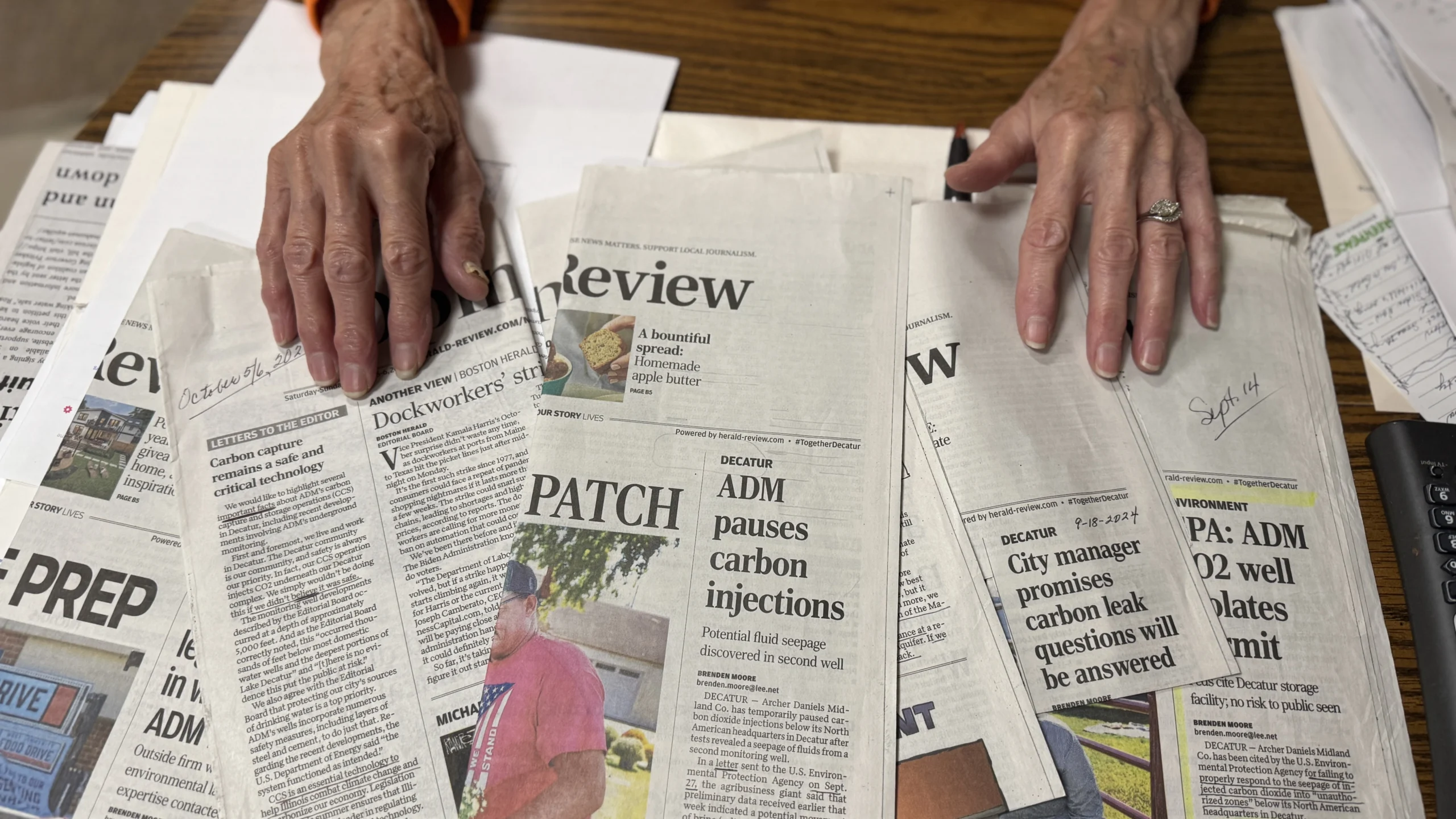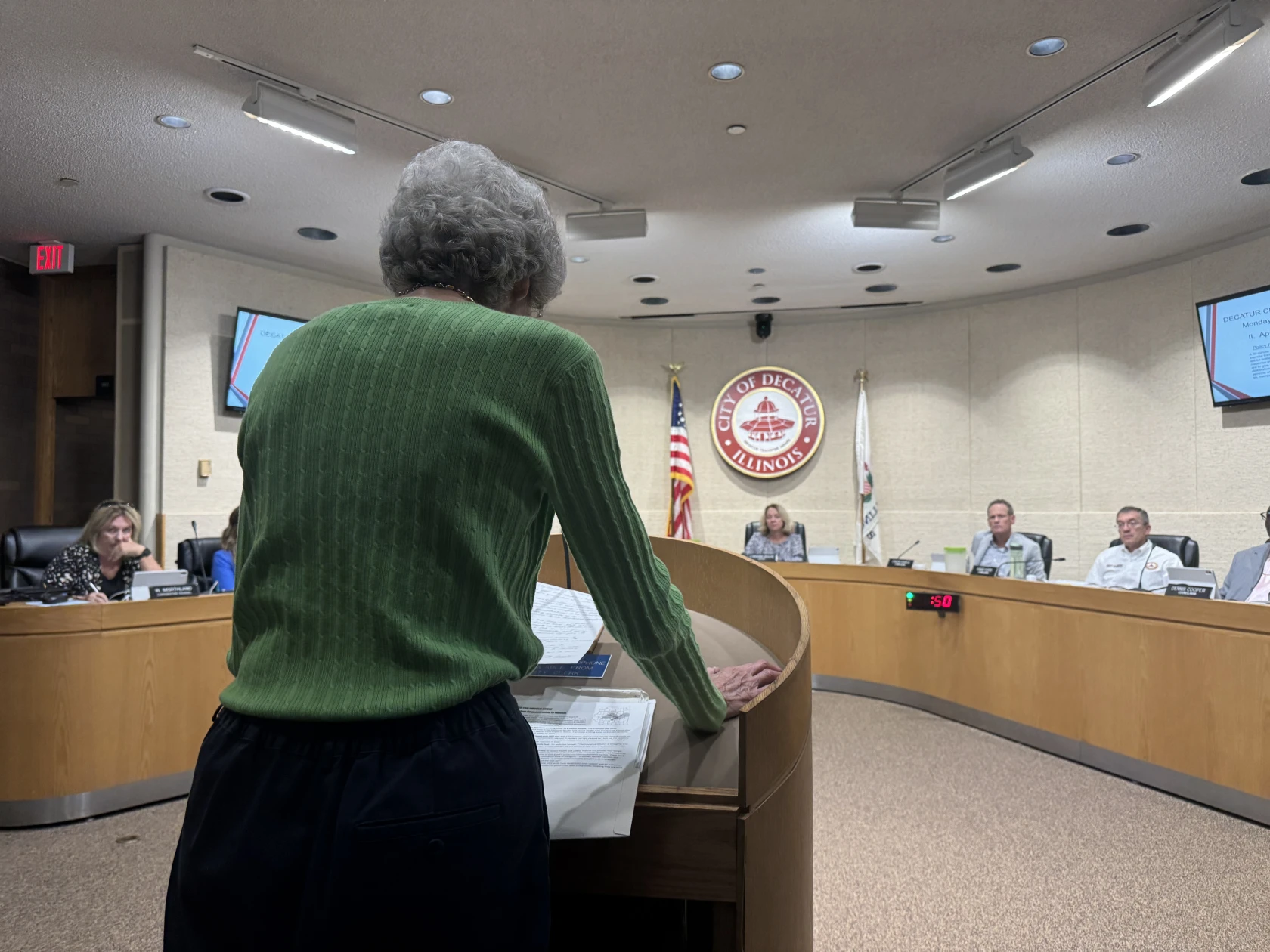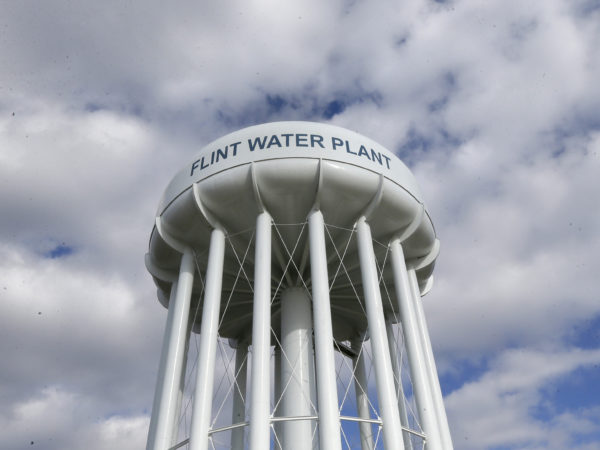
By Juanpablo Ramirez-Franco, WBEZ
This coverage is made possible through a partnership between WBEZ and Grist, a nonprofit, independent media organization dedicated to telling stories of climate solutions and a just future. Sign up for WBEZ newsletters to get local news you can trust.
A row of executives from grain-processing behemoth Archer Daniels Midland watched as Verlyn Rosenberger, 88, took the podium at a Decatur city council meeting earlier this month. It was the first meeting since she and the rest of her central Illinois community learned of a second leak at ADM’s carbon dioxide sequestration well beneath Lake Decatur, their primary source of drinking water.
“Just because CO2 sequestration can be done doesn’t mean it should be done,” the retired elementary school teacher told the city council. “Pipes eventually leak.”
ADM’s facility in central Illinois was the first permitted commercial carbon sequestration operation in the country. It’s on the forefront of a booming, multibillion-dollar carbon capture and storage (CCS) industry that promises to permanently sequester planet-warming carbon dioxide deep underground. This emerging technology has become a cornerstone of government strategies to slash fossil fuel emissions and meet climate goals. Meanwhile, the Biden administration’s signature climate legislation, the Inflation Reduction Act, has supercharged industry subsidies and tax credits and set off a CCS gold rush.
North Dakota and Wyoming administer their own carbon sequestration permitting programs and between them there are more than 10 permitted sequestration wells. The EPA has issued permits for four carbon sequestration wells in the United States — two each in Illinois and Indiana — but many more are on the way. Three proposed pipelines and 22 wells are up for review by state and federal regulators in Illinois, whose geography makes it especially well suited for CCS. Nationwide, the U.S. Environmental Protection Agency is reviewing 150 different applications.

Verlyn Rosenberger spoke at a Decatur city council meeting earlier this month, raising concerns about the ADM leak. “Just because CO2 sequestration can be done doesn’t mean it should be done.” (Photo Credit: Juanpablo Ramirez-Franco/WBEZ)
But if CCS operations leak, they can pose significant risks to water resources. The pressurized CO2 stored underground can escape and potentially propel brine trapped in the same area toward potable water. The leaks can cause heavy metal contamination and potentially lower pH levels, making water undrinkable. This is what bothers critics of carbon capture, who worry that it’s solving one problem by creating another.
In September, the public learned of a leak at ADM’s Decatur site after it was reported by E&E News, which reports on energy and environmental issues. Additional testing mandated by the EPA turned up a second leak later that month. The EPA has confirmed these leaks posed no threat to water sources. Still, they raise concerns about whether more leaks are likely, whether the public has any right to know when leaks occur and if CCS technology is really a viable climate solution.
Officials with Chicago-based ADM spoke at the Decatur City Council meeting immediately after Rosenberger. They tried to assuage her concerns. “We simply wouldn’t do this if we didn’t believe that it was safe,” said Greg Webb, ADM’s vice president of state government relations.
But ADM kept local and state officials in the dark for months about the first leak. The company detected it back in March, five months after it discovered corrosion in the tubing in the sequestration well. Neither were disclosed as the company petitioned the city of Decatur this spring for an easement to expand their operations. ADM also remained tight-lipped about the leak during major negotiations over the state’s first carbon capture and sequestration regulations, the SAFE CCS Act, between April and May, according to several parties involved.
As a result, when Gov. JB Pritzker signed those CCS regulations into law at ADM’s Decatur facility in July, he was unaware of the leak that had occurred more than 5,000 feet below his seat, his office confirmed.
“I thought we were negotiating in good faith with ADM,” bill sponsor and state Sen. Laura Fine, D-Glenview, said in a statement. “When negotiating complex legislation, we expect all parties to be forthcoming and transparent, in order to ensure we enact effective legislation.”
It’s unclear whether ADM was required by law to report the leaks any sooner than they did. According to the company’s permits, it only has to notify state and local officials if there are “major” or “serious” emergencies. The EPA wouldn’t comment on whether ADM was required to disclose, and neither the EPA nor ADM would confirm if the two leaks in Decatur qualified as “minor” emergencies.
In a statement, an ADM spokesperson said “the developments occurred at a depth of approximately 5,000 feet. They posed no threat to the surface or groundwater, nor to public health. It is for those reasons that additional notifications were not made.”
The leak was “substantive, relevant information”
That’s small comfort to Jenny Cassel, a senior attorney with Earthjustice, a nonprofit environmental law firm.
“It’s a little terrifying,” Cassel said. “Because if the operator, in fact, made the wrong decision, and there is, in fact, a major problem, then not only will local officials not know about it, EPA [is] not going to know about it, which is indeed what appears to have happened here.”
The Illinois Clean Jobs Coalition, which applauded the regulatory bill, called ADM’s decision to keep the March 2024 leak from the public “unacceptable and dangerous.”
David Horn, a city council member and professor of biology at Decatur’s Millikin University, said the city was blindsided. “This information was substantive, relevant information that could have influenced the terms of the easement that was ultimately signed in May of 2024,” he said. Horn added that the delay in disclosure calls into question the long-term safety of CCS and the ability of the EPA to protect water in the face of future CCS mishaps.
ADM waited until July 31 to notify the EPA of the leak, more than three months after it was discovered. The EPA alerted a small number of local and state officials and ordered the company to conduct further tests. It also issued a notice for alleged violations, citing the movement of CO2 and other fluids beyond “authorized zones” and ADM’s failure to comply with its own monitoring, emergency response and remediation plans.
But the infractions weren’t made public until Sept. 13, when E&E News first reported the leak.
Two weeks later, ADM notified the EPA that it had discovered a second suspected leak. Only then did they temporarily pause CO2 injections into the well.
Horn says that isn’t good enough.
“The ADM company was aware of the leak in March, and we were not aware of it until September,” he said. “So really, the city of Decatur, its residents, the decision-makers, have been on the back foot for months.”
The city of Decatur has contracted with an environmental attorney. They have yet to pursue any legal action.
Ideal conditions for CCS in Illinois
Central Illinois is a national hotspot for the nascent CCS industry because of the Mount Simon Sandstone, a deep saline formation of porous rock especially suitable for CO2 storage. It underlies the majority of Illinois and spills into parts of Indiana and Kentucky. It also has an estimated storage capacity of up to 150 billion tons of CO2, making it the largest reservoir of its kind anywhere in the Midwest.
However, there is concern that pumping CO2 into saline reservoirs near subsurface water risks pushing pressurized CO2 and brine toward those resources, which would pose additional contamination risks. “Brine is pretty nasty stuff,” said Dominic Diguilio, a retired geoscientist from the EPA’s Office of Research and Development. “It has a very high concentration of salts, heavy metals, sometimes volatile organic compounds and radionuclides like radium.”
Horn says with so many more wells planned for Illinois, the Decatur leaks should be a wake-up call, not just to the city but to the region. He is particularly concerned about any future wells near east-central Illinois’ primary drinking water source, the Mahomet Aquifer, which lies above the Mount Simon Sandstone formation.

Verlyn and Paul Rosenberger at the Decatur City Council meeting where they came to speak out against the risks of carbon dioxide sequestration. (Photo Credit: Juanpablo Ramirez-Franco/WBEZ)
Close to one million people rely on the Mahomet Aquifer for drinking water, according to the Prairie Research Institute. In 2015, the EPA designated the underground reservoir a “sole source,” meaning there are no other feasible drinking water alternatives, should the groundwater be contaminated. When it comes to the Mahomet Aquifer, “there is no room for error if there is a mistake,” said Horn.
In light of the CCS boom headed their way, rural Illinois counties are stepping up to protect themselves from future carbon leaks, said Andrew Renh, the director of climate policy at Prairie Rivers Network, a Champaign-based environmental protection organization.
DeWitt County, half an hour north of Decatur, passed a carbon sequestration ban last year. To Decatur’s west, Sangamon County previously expanded an existing moratorium on transporting or storing CO2 underground. Just last week, Champaign County, directly east of Decatur, advanced an ordinance to consider a twelve-month moratorium on CCS.
Rehn said his organization would like to see all 14 counties that overlap the Mahomet Aquifer impose such bans.
In the meantime, his hope is that state legislators finish what the Illinois counties have started. Two companion bills introduced earlier this year would patch up the regulatory gaps left by the CCS bill Pritzker signed into law this summer. The bills would outright prohibit carbon sequestration immediately in and around the Mahomet Aquifer.
“My community, as well as many surrounding areas, depend on the Mahomet Aquifer to provide clean drinking water, support our agriculture and sustain industrial operations,” bill sponsor and state Sen. Paul Faraci, D-Champaign, said in a statement. “Protecting the health and livelihood of our residents and industries that rely on the aquifer must remain our top priority.
As the Decatur city council meeting adjourned last week, Rosenberger helped her husband, Paul Rosenberger, put on his coat. The row of ADM officials behind her walked past and then lingered in the council chamber. “I’m not afraid of them,” Rosenberger said as she wheeled her husband out.
“We haven’t changed anything yet,” Rosenberger told WBEZ. “But I think maybe we can.”
Correction: The EPA has issued permits for four carbon sequestration wells. States like North Dakota and Wyoming issue their own permits.
Catch more news at Great Lakes Now:
Chicago’s beach season is over … or is it? Lake Michigan temps are breaking records.
Trying to build a more climate-resilient Chicago, one balloon at a time
Featured image: Verlyn Rosenberger, 88, is among the many people in her central Illinois community who only learned about leaks at a nearby at carbon dioxide sequestration beneath Lake Decatur, their primary source of drinking water, from news reports. (Photo Credit: Juanpablo Ramirez-Franco/WBEZ)




